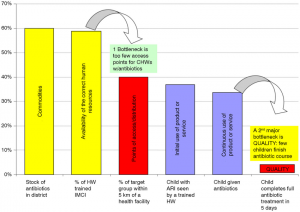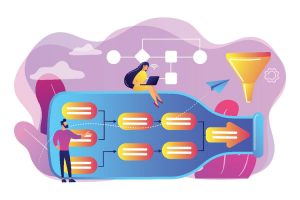
Table of Contents
What do we mean by bottleneck?
- The dictionary meaning of ‘bottleneck’ is ‘narrow entrance or passage’.
- However, while doing a certain task, the term ‘bottleneck’ refers to the challenges, hurdles or obstacles in that task.
- Bottleneck is a factor that constraints the service delivery/delivery of goods and services.
- A bottleneck is the point of a process where the flow is constrained and is affecting the entire work.
- Bottlenecks are the reasons that obstruct the project or planned activities. It can be considered as a point in which a certain activity gets impaired or halted.
- In other words, bottleneck is a work stage where the workflow is interrupted and delayed due to various internal or external factors.
- Bottleneck restricts or constraint the flow of information, production, productivity, effectiveness and efficiency of work.
Types of bottleneck:
There are basically two types of bottleneck. They are:
1. Short term bottleneck:
- These are caused by temporary problems. It will only remain for a shorter period of time.
- E.g.: Obstruction in supply chain, delayed release of budget, limited staffs due to festivals, limited manufacturing due to limited stock and reduced demand of goods etc.
2. Long term bottleneck:
- These are the bottlenecks that are recurring. It will remain for a longer period.
- It affects the production line and productivity of a project by a huge margin. Thus, they are also considered as a major bottleneck.
- E.g.: Lack of appropriate technologies, limited fund and resources, disorganized working mechanism, lean manufacturing etc.

What are the major reasons of bottleneck?
Bottlenecks are the challenges or obstacles in a certain work. Usually, there are three major factors responsible for bottleneck. They are:
- People/human resource: Limited staffs, lack of capacity building and inadequate training etc.
- Systems and technologies: Lack of modern technologies and equipment, outdated technologies, slow manufacturing process etc.
- Organization: Lack of rule of law, poor leadership, lack effective monitoring and evaluation mechanism, lack of staffs’ appraisal etc.
What is bottleneck analysis (in programs and projects)?
- Bottleneck analysis is a process where the bottleneck of any programs, projects or organization is assessed and evaluated.
- A bottleneck analysis is a detailed process of analysis, where an organization gathers data on flow of products or process especially where the work is bottle necking or obstructed.
- A bottleneck analysis provides deeper insights into ‘why’ certain things don’t work. It gives us more information than just stating the problem.
- Bottleneck analysis is more useful for planning process. The analysis helps us to identify the hurdles, obstacles and gaps in the programs/projects.
- It also helps us to identify the process bottlenecks and take essential measures to remove that bottleneck.
- Bottleneck analysis is also essential to ensure effective coverage and efficiency of the program at the community levels.
- The analysis done particularly to point out the cause of bottleneck or to study about methods where a bottleneck is likely to occur in near future is known as bottleneck analysis.

What is bottleneck analysis (in health sector)?
- Bottleneck analysis in health sector means identifying the barriers for effective and efficient health service delivery.
- It includes identifying the barriers or obstacles (physical barriers, social barriers, economic barriers etc.) that are hindering the smooth implementation of health programs and projects.
- Bottleneck analysis in health sector must be done by the health workers, program implementer or concerned stakeholders.
- In health sector, ‘tanahashi model’ is widely used to identify the bottleneck of the health system.

Common examples of ‘bottleneck’ in project planning and implementation:
- Limited resources (human, financial and material).
- Absence of/limited technology and infrastructures.
- Limited geographic coverage.
- Irregularity in utilization of services by the beneficiaries.
- Insufficient community participation and engagement.
- Absence of harmonized supply chain.
- Lack of trust and harmony between the project implementer and beneficiaries.
- Lack of effective and efficient service delivery mechanism etc.
How to identify bottleneck?
Mainly, there are two different ways for identifying bottleneck of any programs/projects.
1. Identifying the place and root causes of bottleneck:
a) Identifying the possible place of ‘bottleneck’
There is a simple technique that we can use to identify the place where the bottleneck might be present. It includes three steps;
- Mapping the activities and the resources available for each activity
- Keeping track of the work and its progress.
- Assessing time consumption at each stage of work: If some work is taking longer time at certain stage, it is clear that we have some bottlenecks in that stage.
b) Identifying the root causes of bottleneck (Analysis tool)
After identifying the possible places of bottleneck, we need to identify the root cause of bottleneck.
For any programs, policies or intervention, there are various ways/methods to analyze the bottleneck and its root causes. In this article, we will discuss some of the common approaches that are widely used for identifying bottleneck and its root causes. They are:
- Key informant interviews (KII)
- In-depth Interviews (IDIs)
- Focused Group Discussions (FGDs)
- Fish bone method

- ‘5xWHY technique’: Asking minimum five ‘5xWHY’ questions to drill down on root causes of bottlenecks
- Brainstorming
- Group discussion etc.
2. Following nine-step process (for bottleneck identification):
- Create a flowchart of all the steps of a program i.e. from start to the finish.
- Calculate the average time and efficiency of each of the process.
- Create a visual representation of the time and efficiency of each process.
- Discuss with the team members, concerned stakeholders and service providers about the expected/ideal effectiveness and efficiency at each step of the operation/work.
- Compare current Vs expected work performance, effectiveness and efficiency
- Determine the impact that the identified bottlenecks are having on the entire work and production process.
- Describe the identified bottleneck in terms of quantitative impact. E.g. what % of people are unable to utilize the services due to limited service coverage?
- Create a cause and effect diagram to assess the reasons of the bottleneck.
- Identify and determine the root cause of the bottleneck.
Who will identify the bottleneck? 
- Program planner and designer
- Program implementer
- Concerned stakeholders
- Supervisors
- Program evaluators
- Beneficiaries (sometimes)
Advantages of bottleneck analysis:
- Helps us to eliminate the bottleneck and achieve smooth workflow process.
- Helps us to collect relevant quantitative and qualitative data for effective and efficient service delivery.
- Helps us to increase work efficiency, productivity and production.
- Ensures effective and efficient utilization of local resource/s.
- Prevents recurring of long-term bottleneck.
- Enhances performance metrics of the staffs and creates an enabling environment at the workplace.
- Supports to streamline the workflow – Once the bottleneck is addressed, work can flow through from start to finish in at an even rate.
- Optimizes program output.
- Helps to eliminate/reduce the waste – Bottlenecks are often caused by unnecessary or inefficient processes, which result in a variety of types of waste. Being aware of the waste is the first step in having it eliminated.
- Improves Knowledge – The more a company knows about a specific process, the easier it is to make smart decisions.
References and For More Information:
https://mosimtec.com/5-insightful-bottleneck-analysis-examples/
https://www.sciencedaily.com/releases/2015/04/150430091750.htm
https://www.ennonline.net//fex/54/bottleneckanalysistool
https://www.unicef.org/evaldatabase/files/UNICEF-MoRES_pubs-Annexes-web.pdf
https://www.heflo.com/blog/process-optimization/process-bottleneck-analysis/
https://kanbanize.com/lean-management/pull/what-is-bottleneck/
https://www.creativesafetysupply.com/articles/bottleneck-analysis/
http://www.phf.org/resourcestools/Pages/Process_Bottleneck_Analysis.aspx